
If there were high water, it would probably be adventurous, but it would certainly still be a beauty with a noble profile, rain or shine: the ‘Serenissima’, the ‘Dominant’, the ‘Queen of the Adriatic’, we are in the presence of Venice![]() , one of the most beautiful cities in the world and considered, together with its lagoon, among the Italian ‘world heritage’ sites by Unesco. Goethe had already seen this coming in the 19th century in ‘Italian Journey’: ‘All that surrounds me is full of nobility, it is the grandiose and venerable work of human forces united, it is a monument not of a single prince, but of an entire people’.
, one of the most beautiful cities in the world and considered, together with its lagoon, among the Italian ‘world heritage’ sites by Unesco. Goethe had already seen this coming in the 19th century in ‘Italian Journey’: ‘All that surrounds me is full of nobility, it is the grandiose and venerable work of human forces united, it is a monument not of a single prince, but of an entire people’.
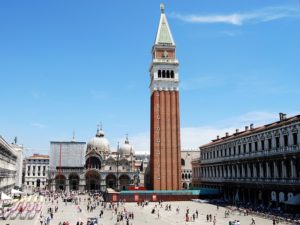
The most famous place is ‘St. Mark’s Square’ ![]() , the only one for which the definition of ‘campi’ or ‘campielli’ is not used, at the centre of which is the ‘St. Mark’s Basilica’, coloured in gold and covered with mosaics telling the history of the city, with several bas-reliefs depicting the months of the year. Joined by the ‘Porta della Carta’, a work by Bartolomeo Bono, next to the Basilica is the ‘Palazzo Ducale’
, the only one for which the definition of ‘campi’ or ‘campielli’ is not used, at the centre of which is the ‘St. Mark’s Basilica’, coloured in gold and covered with mosaics telling the history of the city, with several bas-reliefs depicting the months of the year. Joined by the ‘Porta della Carta’, a work by Bartolomeo Bono, next to the Basilica is the ‘Palazzo Ducale’![]() , currently used as a museum, with works by the best Venetian artists, it also houses the ‘Biblioteca Sansoviniana’.
, currently used as a museum, with works by the best Venetian artists, it also houses the ‘Biblioteca Sansoviniana’.
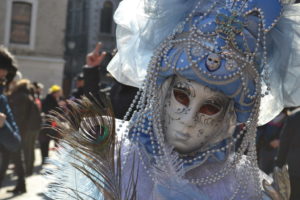 Right in front of the Doge’s Palace, the ‘Campanile di San Marco’ is part of the not-to-be-missed ‘Flight of the Angel’ event that takes place during the world-famous ‘Carnival of Venice’. The origins of this celebration are very old: the first testimony dates back to a document by Doge Falier, dated 1904, in which the word ‘Carnival’ is mentioned for the first time. Towards the middle of the 16th century, an extraordinary event caused quite a stir: a young Turkish acrobat managed to walk on a very long run that started from a boat anchored in the Piazzetta way, reaching the balcony of the Doge’s Palace, paying his respects to the Doge. Such was the success that the ‘Svolo del turco’ was born, scheduled every Shrove Thursday as a real celebration. Over the years it has obviously undergone many transformations, becoming the
Right in front of the Doge’s Palace, the ‘Campanile di San Marco’ is part of the not-to-be-missed ‘Flight of the Angel’ event that takes place during the world-famous ‘Carnival of Venice’. The origins of this celebration are very old: the first testimony dates back to a document by Doge Falier, dated 1904, in which the word ‘Carnival’ is mentioned for the first time. Towards the middle of the 16th century, an extraordinary event caused quite a stir: a young Turkish acrobat managed to walk on a very long run that started from a boat anchored in the Piazzetta way, reaching the balcony of the Doge’s Palace, paying his respects to the Doge. Such was the success that the ‘Svolo del turco’ was born, scheduled every Shrove Thursday as a real celebration. Over the years it has obviously undergone many transformations, becoming the 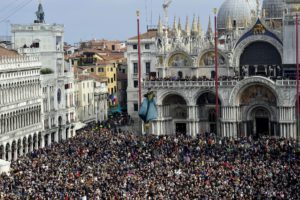 ‘Flight of the Columbine’ in the 18th century. The masks from the Commedia dell’Arte play the leading role and remain one of the most popular gadgets among visitors who can buy them among the characteristic shops.
‘Flight of the Columbine’ in the 18th century. The masks from the Commedia dell’Arte play the leading role and remain one of the most popular gadgets among visitors who can buy them among the characteristic shops.
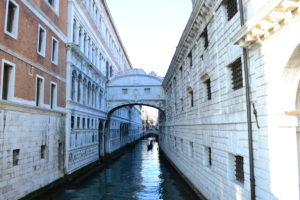
Venice is not just the Carnival. You cannot fail to visit the ‘Sala del Maggior Consiglio‘, for centuries the great seat of government in the world, not to mention the sigh that anyone passing on the famous ‘Bridge of Sighs’![]() ends up heaving, before or after being immortalised. Although Venice is a romantic city, it is not a sigh of love that we are talking about. The bridge, which spans the Rio di Palazzo, connects the Doge’s Palace to the Prigioni Nuove, and was used to take inmates from the prisons to the offices of the State Inquisitors to be judged.
ends up heaving, before or after being immortalised. Although Venice is a romantic city, it is not a sigh of love that we are talking about. The bridge, which spans the Rio di Palazzo, connects the Doge’s Palace to the Prigioni Nuove, and was used to take inmates from the prisons to the offices of the State Inquisitors to be judged.
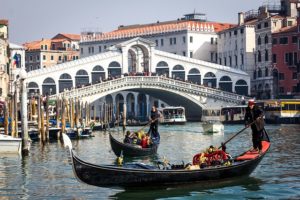
Its name derives precisely from this: from the last sigh that prisoners exhaled as they thought they would see the outside world for the last time. The bridge perhaps as famous as the sigh bridge, but certainly in the past more ‘pleasant’ to cross, is the Rialto![]() , an imposing old bridge over the ‘Grand Canal’
, an imposing old bridge over the ‘Grand Canal’![]() , whose construction was at the centre of an architectural stylistic debate for a good eighty years. Nearby is the Rialto
, whose construction was at the centre of an architectural stylistic debate for a good eighty years. Nearby is the Rialto ![]() , the Venetian market par excellence.
, the Venetian market par excellence.
